
23 minute read
Renewable Energy Infrastructure p
Circular Economy: Third Industrial Revolution Renewable Energy Infrastructure
by Deichler Miles Jacob biogas system
Advertisement
waste collection
waste collection
biogas system

plot A (energy generators)

waste collection
household
food production kitchen waste
Home Biogas System
fertilizer
energy biogas
Reducing the usage of electricity and the waste of biomass in the common household kitchen is the ultimate aim of this proposed “circular economy” system. To capture an idea of how negatively impactful food waste is on the biosphere, “ food wastage’s carbon footprint is estimated at 3.3 billion tonnes of CO2 equivalent of GHG released into the atmosphere per year.” This is the equivalent of three times all pollution generated from transportation in the United States in a year. In regards to electricity, Spain is the 7th most wasteful country in the world when it comes to household electricity usage. A solution exists to decrease wastefulness and ecological footprint on both of these fronts in the Madrid community. In order to reduce the natural kitchen waste impact of this community, I propose to put a space-effi cient HomeBioGas system outside of the apartment buildings or by utilizing rooftops (although, they look to be clay and slanted).
What this system does is convert organic waste into biogas and liquid fertilizer through a process called anaerobic digestion . This is all done by growing a “healthy colony of bacteria”2 on the inside of the tent-like structure to allow for bacterial breakdown of organics while trapping the gas emitted from the process. The tent’s would be placed outside of apartment complexes for the purpose of being exposed to sunlight, as the bacteria thrive in warmer conditions. Traditionally, the gas produced from this system goes straight towards kitchen-usage.
In this system however, our intention is to turn this biogas into a form of sustainable electricity creation. The electricity could then be used to power household utilities. Small-scale household methods exist for using portable generators to convert biogas, and this would allow each apartment complex to operate off of the electricity grid. An alternative would be to construct an electricity utility facility on Plot A with powerful engines such as the CAT 3250 Gas Generator.
For this to work though, a large underground infrastructure system would have to be devised to transfer the gas from the HomeBioGas units to the facility by pipeline or storage containers.
Buenavista takes care of our planet An energy self-suffi cient neighborhood


by González Rodríguez De Biedma María
pedestrian streets

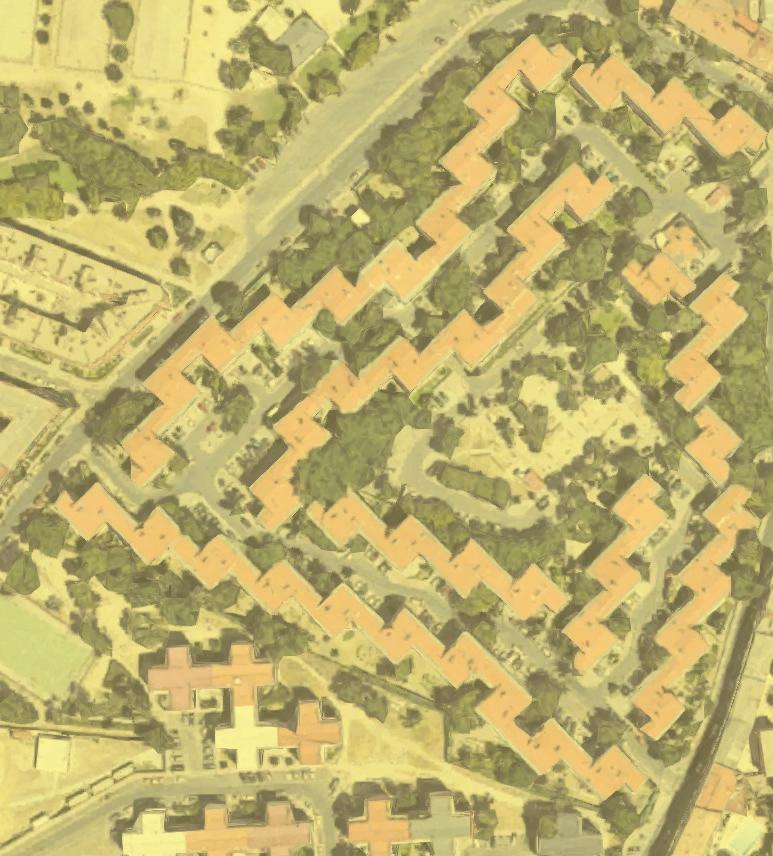
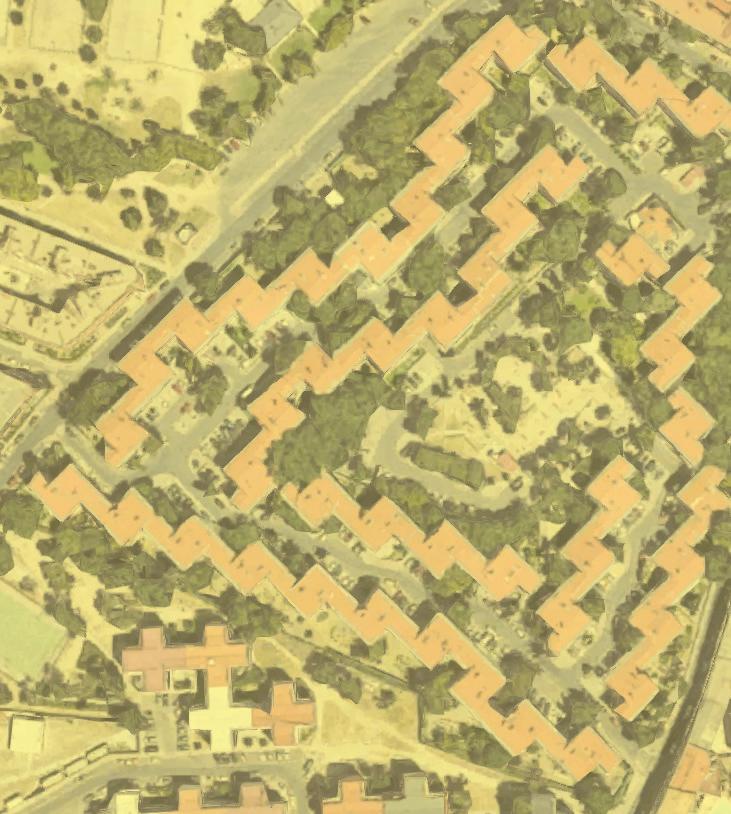

improved playground
electrical car-park

localy sourced energy for street lighting
improve infrastructure understanding renewable energy
sharing energy profi ts
heat & electricity clean energy implementation
Buenavista is a neighborhood situated in Carabanchel Madrid, it is composed of around 46 building blocks, and more less 552 houses, most of them occupied by small families.
My self-suffi cient system relies on two key elements, the production of self-suffi cient energy sources and the cooperation and strengthening of the neighborhood community. The Energetic system will be off-grid and it will take advantage of the sunny weather of Madrid (around 2740 sun hours per year) relying in two main renewable energy sources, the sun (solar energy) and the heat inside the earth (geothermal energy). This centralised system will supply energy to all the building blocks and it will count with a storage installation to cover all energy consumption during nights and when it is cloudy.
To be more concise about the system functioning, I have calculated that up to 5670 solar panels can be placed in the roof- tops of these houses, which count with a total surface of 11340 square meters. Given that an average electric energy consu- me for an small household in Madrid will be of 3487kWh per year1, and that 3 solar panels of 320W(average power) cover 2000 kw of energy per year4, each household could have all their electric energy needs covered with 5 solar panels3. The- refore 5670 solar panels could cover 24/7 electric energy needs of these houses and even make extra energy production. Nevertheless, we have to consider that 3487kWh is the electric energy used in every household, this means lighting, tech- nologies and appliances like fridges etc., In terms of the heating, most of the houses in Spain get the heating from gas sources. Here it is where the second energy source is needed. Geothermic power will supply energy to an under-fl oor heating system that will cover all the heating needs of the community. An installation which will count with lithium batteries will be placed in the empty plot located right next to the building blocks to ensure the storage and proper distribution of the energy to all the houses. Moreover, the excavations needed to extract the geothermal energy, plus all the machinery and the transformation center will also be placed in this installation in the empty plot. So this installation will become the “heart” of the community. The spare space in the plot will be used for a parking for the members of the community that will allow space for walking in the inner streets of the neighborhood.
Moreover, the proposal emphasizes the importance of creating a connected and strong community that could directly improve public space and that is concerned of the importance of renewable sources and the benefi ts that self-sustainability can bring. Therefore it is essential that all neighbors are involved in the understanding and management of the project. Neighbors will gather at the beginning of the project to stablish some rules, they will design a plan to see where and how they will use the income gained form the extra production of solar energy. This plan could consider investments in a better lighting of the public space (using the excesses of the solar energy production), elevators for the building blocks, painting and fi xing the façades to improve the esthetics of the site, improving the installations of the community park etc. It is quite obvious that the main issue this project may present is the big initial money investment.
Nevertheless, we could fi nd fi nancial aid from big energy companies such as Naturgy, Repsol, Iberdrola etc. that may be more than interested in being involved in this fi rst prototype of an off-grid self-sustainable neighborhood to associate their enterprise image with this type of “green” initiatives.
An Integrated Neighbourhood : Welcome to the Future Circular Economy applied to Urban Planning
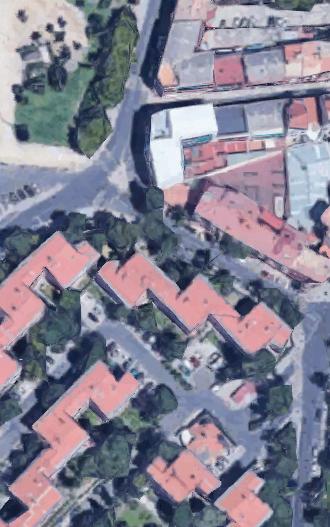

by Laraqui Houssaini Ghali
plot C
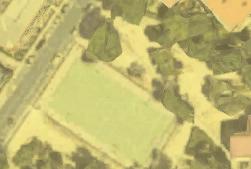
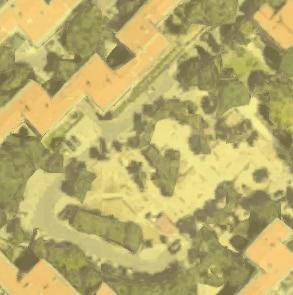
plot B
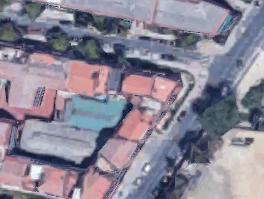

plot A1
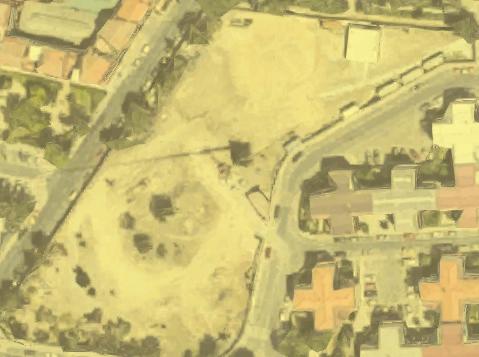

plot A2
sustainable sky farms
food-waste to compost & honeybee farms
colected and recycled water
solar panels & wind turbine (energy production)
clean energy for households& markets
pedestrianized green areas
(car free zones)
underground parking
The model presented in the following lines aims to tackle several issues at once, namely energy production and consumption, food production and management, as well as improved lifestyle through a set of changes applicable to the current urban centre located in Carabanchel, Madrid. This framework of improved urban management does not take into account the fi nancial aspect of the implementation of any of the designs that will be discussed and should only serve as a reference for better use of available space in terms of sustainability and quality of life.
The area of interest in Carabanchel, delimited by the green encircling line, presents several advantages. The fi rst is the presence of three important empty land fi elds – in red, A, B, & C –accounting for a surface area approximating 12,700 square meters, measured through distance data retrieved with Google Maps tools. The second is the proximity of habitable residences to these unused areas. This paper will proceed as follows. In the fi rst section, I will discuss on the potential infrastructures that should be built in area A. Then, I will move on to those of area B to fi nish with those of area C. In the second section, I will develop the circular economy concept underlying the specifi c design of the aforementioned areas. The last section will deal with the potential impacts such design plans will have on the neighbourhood and its inhabitants. into 2 parts, one of 4,375 square meters, sub-area A-1 (down), and another of 3,450 square meters, sub-area A-2 (up). This divide should not be taken in absolute terms, as it is relative to what, in the present moment, is envisioned to be built in such defi ned area-portion. Sub-area A-1 is visualized to accommodate a next generation technology of agriculture, namely vertical agriculture. The choice of this recently developed agricultural technique seems evident.
Indeed, it combines two great perks: 1) Not merely being an extremely effi cient user of space... in essence, this technique creates space as high as its structure goes; 2) A responsible, sustainable use of collected water recycled for the harvest of bio- organic, fresh products.
If we assume the base structure of the adjoined image to be a rectangle of, let’s say, 5 meters in width and 10 meters in length, extended to 6 and 11 for passage of hypothetical workers. The surface area of this delimited structure, which can nest as many batches of water where seeds grow as one may desire – why not a green, agricultural tower? – is 66 square meters.
Assuming that the entire sub-area A-1 is covered by these structures...it represents approximately 66 potential structures able to be constructed. Numbers on the seeds per batch capacity varies, but such structure is highly effi cient, with 30-days crops available for harvests daily. The following model also shows another structure to implementing such sky
farming design, as efficient as the aforementioned one. The water is collected in water tanks placed at the top, from rains notably...but not only, as I will be discussing in the following paragraphs.
Sub-area A-1 is hence dedicated to sky-farming, with potential employee number ranging from 5 to 25, depending on the number of structures and their height. Sub-area A-2, on the other, would take this concept even further: it represents a location for a green supermarket open not only to the resident of the area of interest, but to whoever wants to shop there. Fruits and vegetables of all seasons can be grown, which will be discussed in the designing of area B, as some vegetables, like bananas and others, require a different ‘home-design’ – greenhouse homes. The grown vegetables would present the unique attribute of being green and sustainable in their harvest, changing the entire culture of the region when thinking about farming and grocery shopping for the better.
Opportunities are extremely varied, as this marketplace can offer a location of exchange between farmers in the outer suburbs zones to bring them more incentives to adopt this technology and increase dramatically their output per square meter. The only downside of this technology is the use of electricity which, in the absence of wind-turbines and solar panels, would mean the consumption of unsustainable electricity as a source of light for the plants. Yet, it still offers a tremendous opportunity to improve overall the quality and status of this neighbourhood. As well, sub-area A-2 will leave space for composting zone, in which all the food waste from the local community will be collected and allocated in specific tanks for their later use as fertilizers for the crops in the sky farms. This allow to grow fresh, organic products without the use of chemical fertilizers. Additionally, one may think of building a specific area – not very big – for the development of honeybees harvesting. This would reinforce the sustainability of this entire projects, as bees could fertilize the entire sky farms and bring back to such depleted population its natural habitat.1 On the other hand, Area B, as mentioned, will accommodate complementary vegetables and fruits to area A, and will also be a sky farm along with a greenhouse for specific products. The opportunities are wide, and the farmers will be the ones to choose which commodity to grow, which can be decided by knowing the preferences of the local community through a survey or information exchange session.
Underpinning the entire area A, I thought of constructing an underground parking lot only for the residents of the area of interest and employees of the supermarket and sky farms. This underground parking lot wouldn’t only welcome cars, it would also embed the technology used by artificial grass football pitches to collect water from rain, and redistribute it to the sky farms after cleaning. This would also allow the entire area of interest to be car-free, with the design of road networks exclusive to bicycles. By design, I mean the reallocation of the current roads into bicycles and running areas. It would drastically improve the life of the inhabitants of the zone of interest.
The planning of the underground parking lots joins the envisioned plans for area C. Indeed, area C currently has a very big football pitch, which is essentially a loss of space. Instead, the sport area of 2,884 square meter can welcome three useful infrastructures that would promote a healthier and more responsible lifestyle by the local community:
1) A Basketball court of high-school size, being 290 square meters. 2) A 5-side football pitch, totalling 1003.75 square meters approximately. 3) A gardening area for kids, who can develop an interest in botanic while their parents are at work. This area is extendable to 1550 square meters, as we also have to take into account space for benches, bathrooms, supporters who watch football/basketball games, etc.
The disposition of all areas A, B, and C has to be added to the interesting idea of installing solar panels on top of the roofs of each residence, as well as providing the zone with mini wind-turbines, as the region of Madrid has on average a 7.9 mile per hour of wind yearly. The area of each of the houses marked by a little red line is 245 square meters. Counting 25 rooftops, we can imagine an area of 6,125 square meters potentially available for solar panels. An average solar panel being 9.6 square meters, producing 1.3kW, there is space for 640 solar panels approximately, all producing 830kW of energy per day. Per year, this figure would grow to 302,740kW of energy production. The average Spaniard household consumes around 3,500kWh per year, hence installing this many solar panels would provide electricity for 86 households.3 Other estimations say that a typical home of approximately 1,500 square feet, with electrical costs of about $100 per month generally need 16 panels to cover completely electrical needs, of average surface area 5 square meters. Each roof, as shown, can cover 245 square meters, in other words...49 solar panels.
The mini wind turbines are not as efficient, as they have maximum energy conversion efficiency of 59% of wind force, but they can still help in providing green electrical energy.
Now that the discussion on the new urban designing done, here is my version of the conceptual ‘circular’ economy diagram that arises from such plans:
The impact of such models are various, and effect every side of the economy: - Improved quality of human life: healthy alimentation, habits (sports, socializing with kids gardening and playing sport games together); - Sustainability with sky farms, organic market-place, clean energy production and consumption; - Creation of jobs with the sky farms, the market place, the tutors for the kids gardening; - Change of the local culture towards more sustainable and self-sustaining habits; - A drive for innovation.
The Solution to All the Problems: a Self-Suffi cient Economy : How a local currency can make Buenavista’s people happier



by Lampis Temmink Lauro Amadeo


basic income
(part in euros, part in local currency)
extra income
local residents
local worker local market
local leisure facilities
local services
local facilities
The Current Situation Imagine an average starter family living in Buenavista, Madrid. A working parent, and a stay-at- home parent (not sex-bound), with a recently-born baby. The family does everything to maximise their quality of living given a net income of € 18 000 - roughly € 100 less than the average Spanish income, but € 500 more than the minimum income.
After some calculations based on an educated estimate of what this family buys (Appendix), their annual expenses can be broken down as follows: a) rent = € 8688; b) utilities = € 1620; c) food = € 1200; d) commuting = € 660. They do not have extra expenses on the baby, as one parent stays at home and baby food are included with food costs. Also, they use reusable cloth diapers. Their healthcare comes from the public system.
The subtraction of the annual expenses from the net income = € 5832. However, considering 10% of the income is saved for emergencies, only € 4032 is left for extra expenses (cigarettes, clothing, baby toys, hygiene product, OTC medication, and so forth). To compare, a family in The Netherlands will have roughly € 30 000 to spend per year - a substantial difference. The point? The starter family in Buenavista is relatively stretched for resources, and needs to constantly think about their money. health of teenagers from different socioeconomic levels in 1993, concluding that those with relatively less means were more prone to behavioural problems.3 Once the same group of underprivileged youths then saw their parents’ spending power rise by approximately $ 4000 per year, the number of cases of behavioural problems declined 40% - as well as crime, substance abuse, and their school results rose.4 Most importantly, however, parents fi nally had a little leeway: they had more energy to spend being a good parent, instead of having to work to earn money.5 In a video essay, Casey Neistat - a once poor man with a child living in New York, now a famous YouTuber - distinguished between “money problems” (housing, food, health) and “life problems” (pursuit of happiness, love, and a purpose). His conclusion: money can’t solve all your problems, but it can solve the money problems. It seems only logical.
The Ideal Situation Ideally, then, nobody would have to worry about those basic needs. Not a family, not a student - nobody. This does not mean everyone should be rich because, following Casey’s philosophy, money can only solve problems to a certain extent. This is because money has a marginal relationship to social problems, demonstrated by the fact that America has a GDP/ capita of about $ 35 000 and Portugal one of about half that, but they have the same index of social problems.7 Exchange GDP/capita for inequality, and the picture materialises: countries with more equality have less social problems.8 The goal is therefore not to overload
everyone with cash, but raise those below the line to the average - to increase equality.
The Proposition Everyone in Buenavista should then receive a basic income. No strings attached. Suppose both of the starter parents receive half of the Spanish minimum income for free, this would total the family’s spending power to € 30 600 per year, an overall increase of the total minimum income - and for them, 70%. After expenses, and saving 10% of this amount, this means they have 311% more to spend on other things than just their basic needs. Overall, this would lift them out of their strained position and into one where both parents can focus on their wellbeing, as well as that of the child. But, this is only one step toward the self-sufficient economy of Buenavista. What would keep them from spending all this money on luxuries, or the exact opposite - just hoarding it in the bank? The money somehow needs to contribute toward a more efficient monetary system, circulating in the local economy of the neighbourhood to increase productivity.
What is needed, is for at least part of the money to travel hands rapidly between the inhabitants of Buenavista. That way, the economic value of every unit of that money - following the concept of the velocity of money - is maximised and the economy can expand.9 Why does it expand? Because if the money circulates readily in the economy, meaning the value of every unit rises, the total value of the economy rises.10 To give an example: if everyone pays the local bakery with local currency, he wants to expand the business, and can pay the local builder in the currency to help him - and the local builder, in turn, can spend the currency on a babysitter from the neighbourhood so he has more time to be productive.
Conclusion Buenavista needs a universal basic income, part of which is paid in a local currency that can only be used within the neighbourhood. The “real” money allows the starter family to cover basic needs that must be paid in that way, such as the city’s utilities and the rent, leaving them more time to parent and focus on wellbeing. The local currency then allows them to be more economically active within the neighbourhood, and it provides incentives for others to offer value for the currency - such as the baker or the builder - through which the Buenavista economy can expand. The best thing? The local currency largely circulates by itself, meaning minimal intervention and bureaucratic costs for the government. And the minimum income overall, despite costing money, will probably pay for itself through increased productivity and education. “Basic income is not a utopia. It’s a practical business plan for the next step of the human journey.” - Jeremy Rifkin, US economist
A self-suffi cient Carabanchel Circular-economy in urban neighborhoods

by Hempel Emanuel Theodor



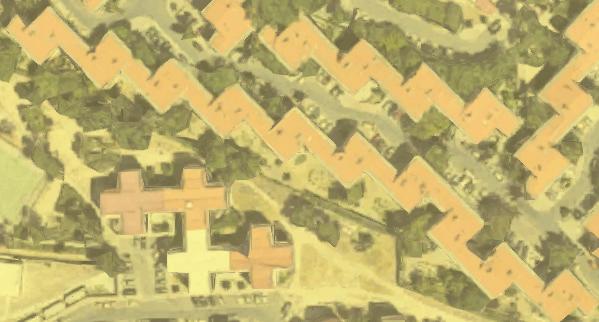

productive roof garden
productive roof garden




organic material
(all organic will be stored and separated to fi t the needs of the next step)
compost
(local authorities collect the compost from each building composting unit ) (anaerobic organic substrat reactor, waste to energy for local households)
energy
(organic waste turned into soil and fertilizer for the roof gardens) soil & fertilizer
(managed by the local residents in collaboration with the authorities)
productive roof garden
(organic waste material from the roof gardens will be stored and processed)
compost
local market
(majority of the produce will be distributed directly to the local residents) (80% distributed among residents equally. 20% goes to the market)
produce
The focus of this project was to implement a circular economy concept in the urban neighbourhood of Carabanchel. The issues that are trying to be tackled with this proposal are food production and energy. While the aim of these implementations is to reduce environmental impact, contribute to a greater quality of life and create space for micro-economies.
This highly ambitious case of urban remodelling would generate 6.453 hectares or 64,530 m2 of agricultural land, by converting the fl at roofs into ones which can support plant life. This process of green roofi ng would cost around 472,937 € and could, hypothetically, provide food for 30-44 people all year around. Besides the requirement of gathering the necessary investment needed, administrative issues would also have to be solved. For this, a plan is proposed that splits the responsibility for this urban agricultural land between the local authorities of Carabanchel, and the residence of households. Under this plan there would be one governing body of the garden per household, who besides fi xing personal issues is also responsible for the maintenance of the garden, and the selling of proceeds, more on that later. In case of this individual not being able to resolve issues, including maintenance or household disputes, local authorities will be handed the responsibility of resolving it. provided to the governing body of the roof garden. This individual can sell the produce on the last Sunday of every month in the local plaza, surrounded by Calle Cortada and Calle de Azcoitia. Permitting the foundations for a micro-economy to arise out of Carabanchel.
Undoubtedly the roof gardens and households will create organic waste, which will be mandatory to separate, as a new compost system across the neighbourhood will permit such actions to be undertaken. The empty plot of land, bottom left of the area in focus, and bordering Camino de la Cruces, will be repurposed to make way for several projects.
Primarily a new compost station will be provided, where organic waste of the neighbourhood, can be converted into energy or soil. Converting organic material into soil, requires land, but besides that is not very capital intensive. A mix of food waste in symbiosis with, for example, grass clippings sourced from local sidewalks and manure, which will have to be purchased from surrounding farmers, overtime can serve as nutritious soil for the roof gardens. Alternatively a sections of the organic waste generated will be fed into a bio gas reactor, here a 100m3 plant will require an initial capital investment of 33,509 € alongside maintenance cost over its 15 year life span.
Another project, which is apart from the circular system, is the installation of 4kW solar panels on every roof. The small community is made up of an estimate of 75 houses, thus the initial capital requirements for the total operation will be approximately 513,150 €, if one panel costs 6,842€. Underneath the solar panel, shade seeking flora such as rucola, Brussel sprouts or lettuce can be grown and harvested, thus productive land will not be diminished.
In conclusion this project will require, according to rough estimations, an initial investments of 1,019,596€, which fails to considered maintenance cost and wages for employees who will manage the system. Furthermore policy changes will need to be implemented to provide the means and convey the population to recycle their organic waste. Roof gardens, the most essential stage of the system, will contribute to food production, standard of living, reduce environmental impact related to food miles and allow the foundations for micro-economies to develop. Furthermore the produce generated and compost/ organic waste will contribute to food production and micro-economies. The energy generated by the bioreactor, provided that there are local demand shortages, can be sold to neighbouring communities and will have to be integrated into the electricity grid. The same concept applies to the soil, whose primary purpose is to contribute to the roof gardens. Lastly the solar panels will allow for higher energy self-sufficiency and will reduce the environmental impact of the area. The project proposed is highly ambitious, has much potential, but fails to recognize and consider several issues and deeply run analysis. These include its financing, a cost-benefit analysis, community support and so much more. Nevertheless it would provide a step in the right direction and the concepts which have been proposed have shown large success, elsewhere, around the globe.









